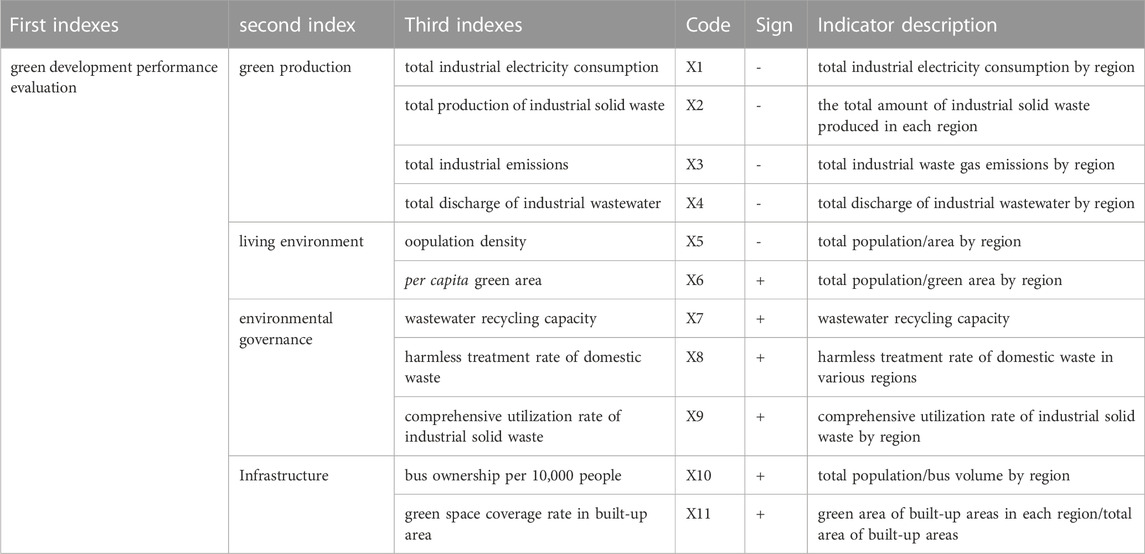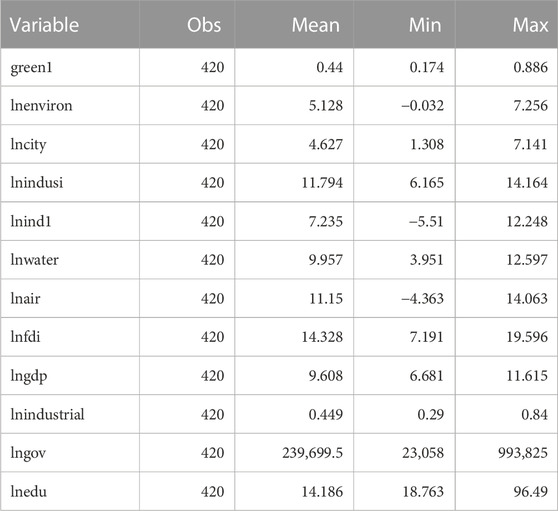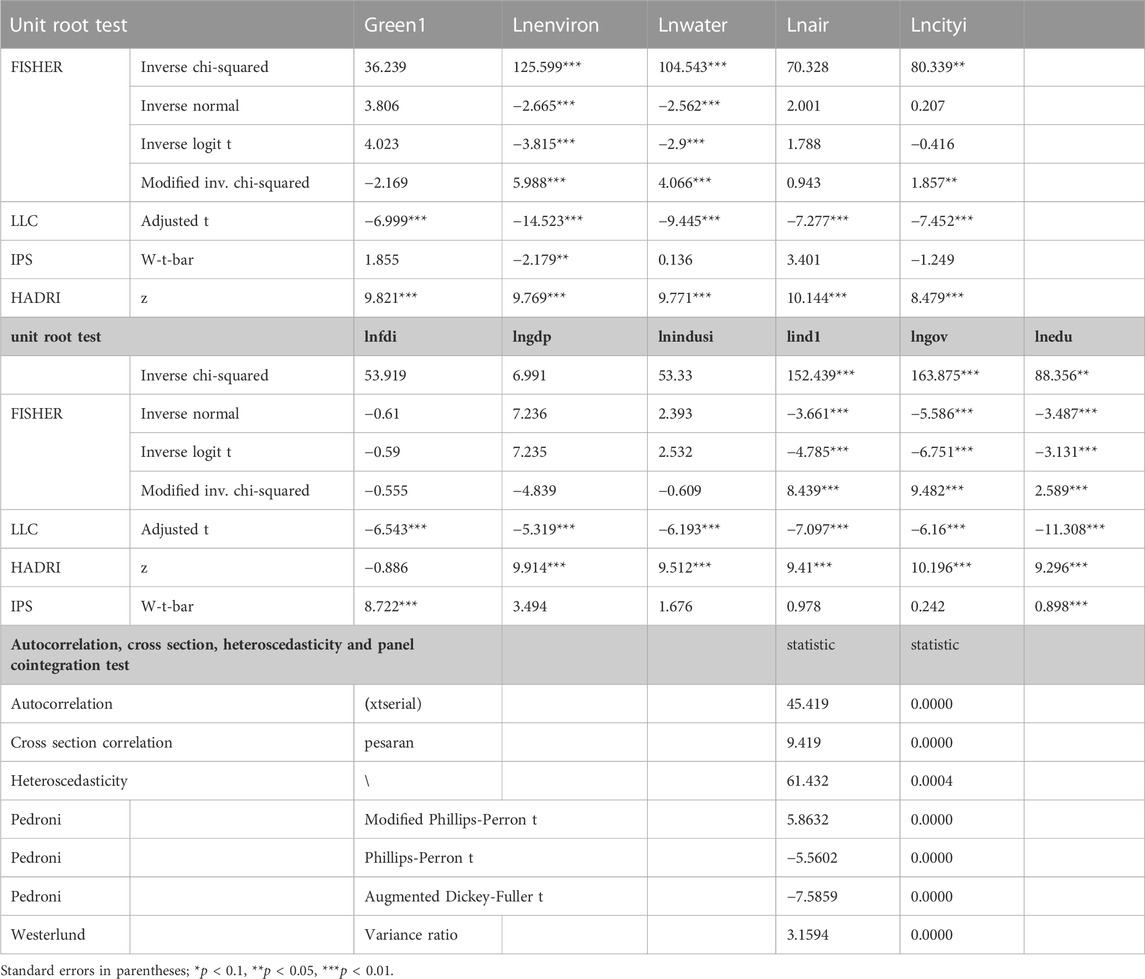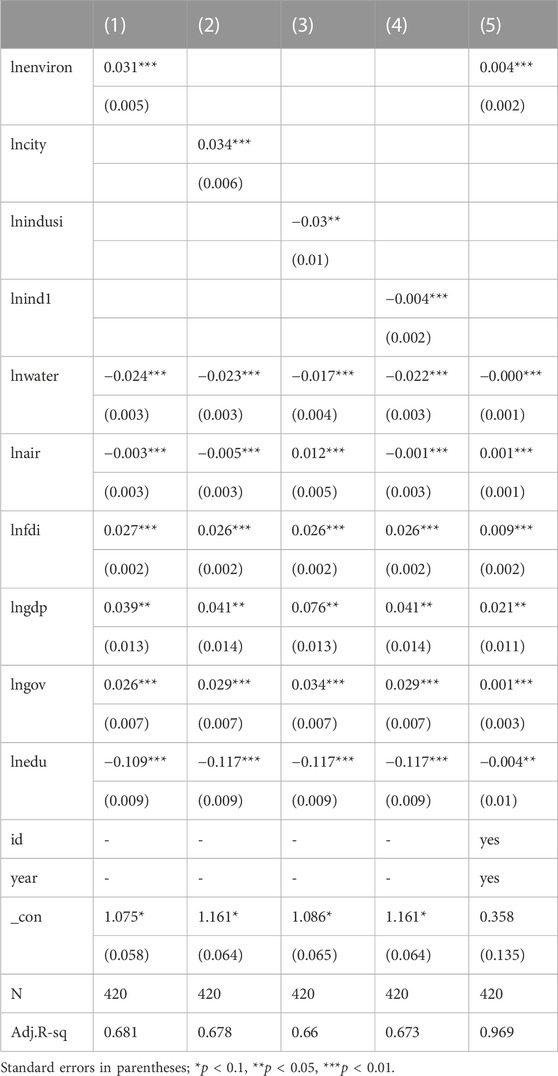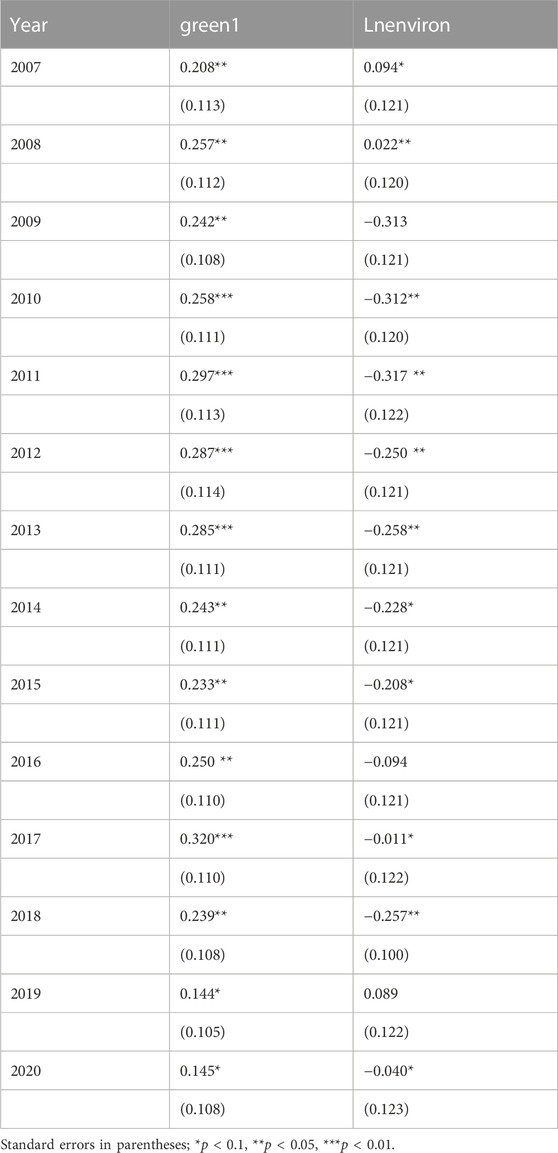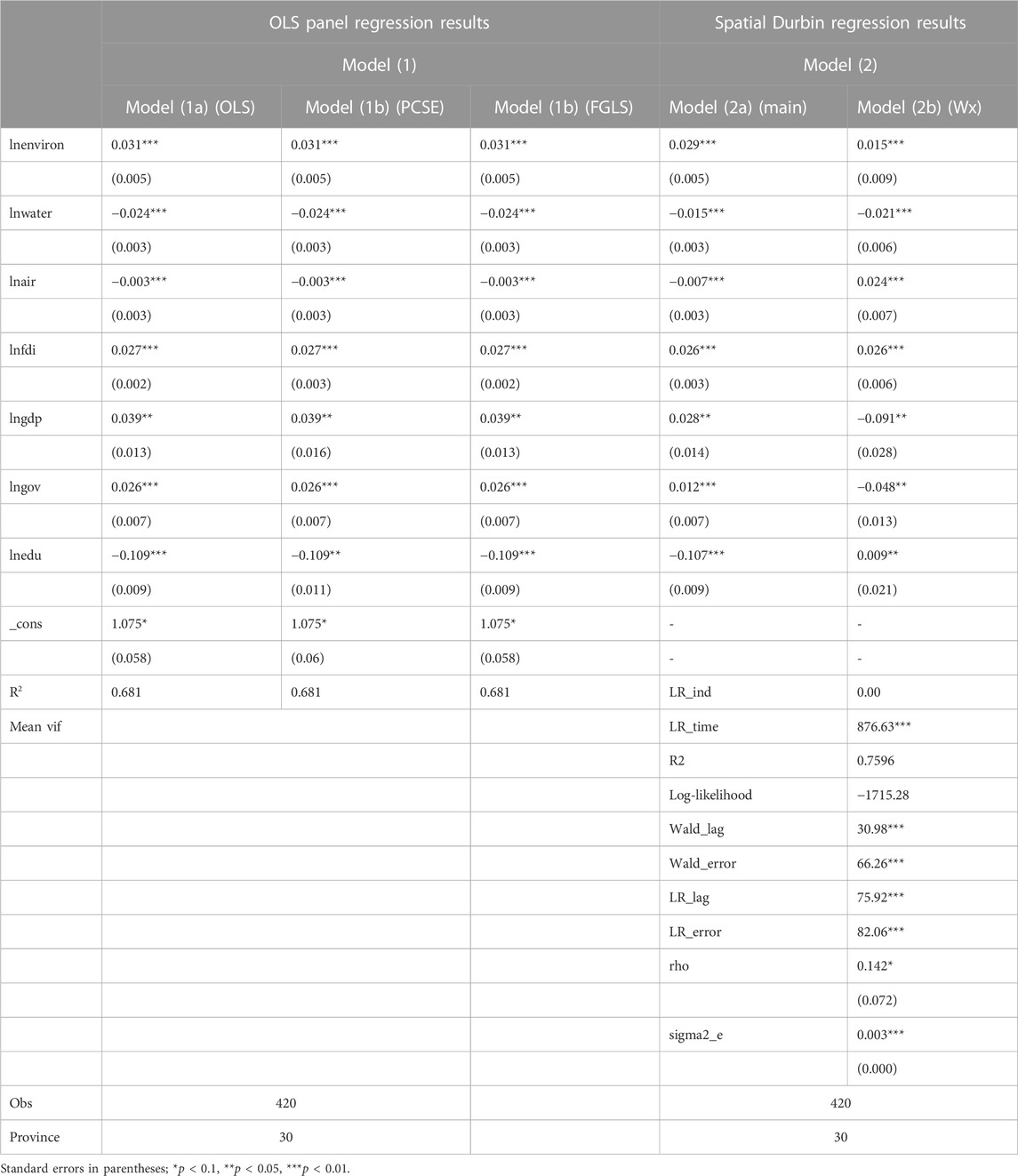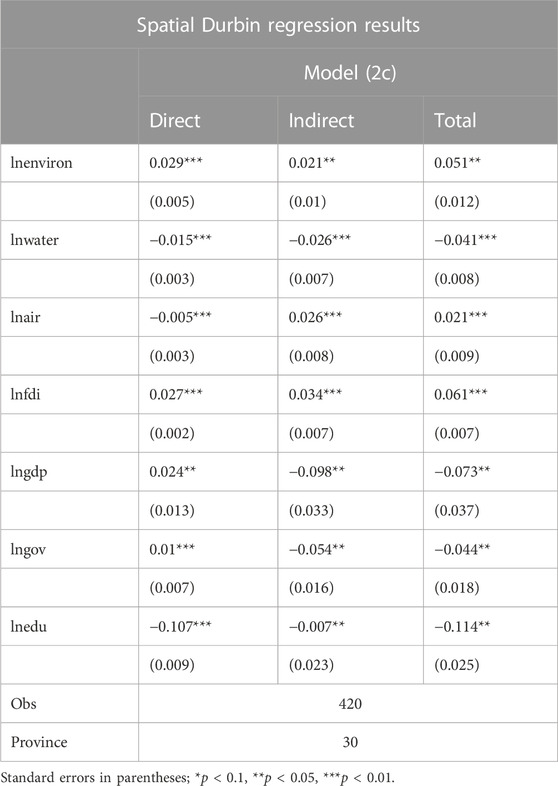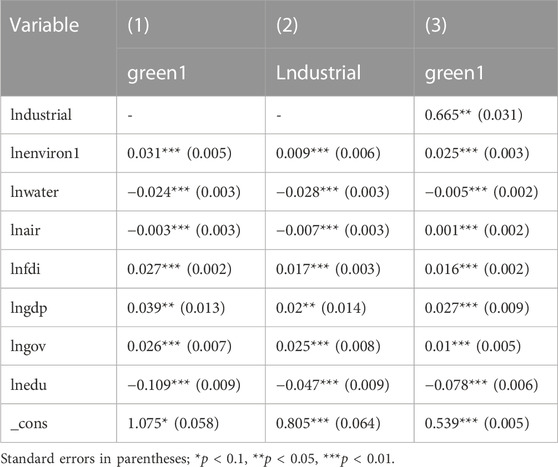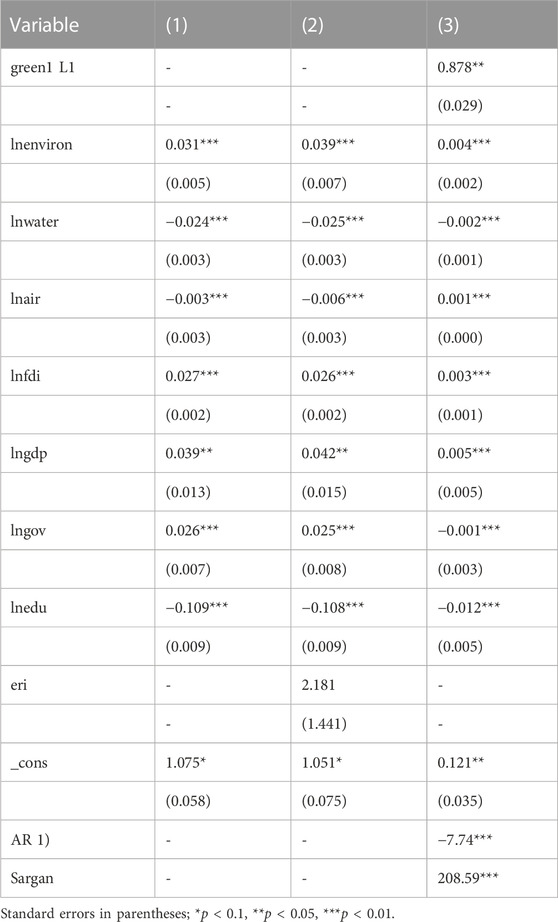- School of Economics, Yunnan University, Kunming, China
As a special category of investment, environmental protection investment can provide important funds and technological support for a region, achieve green production, and promote green development. This article uses a benchmark regression model based on panel data from 30 provinces in China from 2007 to 2020 to analyze the impact of environmental protection investment on the level of green development. It specifically examines the effects of urban environmental infrastructure investment, industrial pollution control investment, and completion of environmental protection acceptance projects on the level of green development. It also explores how different regions can make use of environmental protection investment according to local conditions. Additionally, due to the spatial spillover effect of environmental protection investment, this article introduces the spatial Durbin model to study the spillover effects. Furthermore, in order to effectively promote green economic development through environmental protection investment, it is necessary to upgrade the industrial structure. Therefore, this article also uses the mediation effect model to explore the relationship between environmental protection investment, industrial structure upgrading, and the level of green development. The research findings are as follows: 1) environmental protection investment can promote the development of green level; 2) the various components of environmental protection investment have different effects on the level of green development. Urban environmental infrastructure investment has a promoting effect on the level of green economic development, while industrial pollution control investment and completion of environmental protection acceptance projects have a restraining effect; 3) environmental protection investment has a positive spillover effect in spatial terms, promoting the green development of surrounding areas while driving the local green development level; 4) as an important driving force for promoting green economic development, environmental protection investment relies on the support of industrial structure upgrading, and further optimization and upgrading of the industrial structure can achieve green economic development. Based on these findings, this article proposes that each region should increase environmental protection investment, implement the concept of green development, and leverage the positive impact of each component of environmental protection investment on local green development according to local conditions. At the same time, each region should also pay attention to the role of industrial structure upgrading and make rational use of environmental protection investment to promote green development.
1 Introduction
Green development has always been an important topic in global environmental governance, as countries are suffering from the ecological and environmental pollution issues brought about by the rapid development of industrial civilization (Luo et al., 2021; Cao et al., 2022a). Green development is an economic growth and social development approach with the goals of efficiency, harmony, and sustainability (Frydman et al., 2022; Hu et al., 2023). In the early stages of development, many countries relied on high-energy-consuming industrial enterprises, which, while driving economic growth, also damaged the natural environment (Zhao et al., 2022). At present, the economic and social development of countries around the world requires a transition to green development. From the current perspective, although traditional industries are still the cornerstone of economic development in various countries, governments have gradually realized the important concept of harmonious coexistence between humans and nature. Starting from the adoption of the Kyoto Protocol in 1997 to the United Nations Framework Convention on Climate Change, the control of carbon emissions to mitigate global warming has become a fundamental global rule. In this regard, as the world’s second-largest economy, China has a greater obligation to participate in the global environmental governance process, demonstrating the responsibility of a major country (Wang and Yu, 2020; Pan et al., 2023). The Chinese government has proposed that by 2030, the carbon dioxide emissions per unit of GDP will no longer increase, achieving a “carbon peak”; and by 2060, “zero emissions” will be realized, achieving “carbon neutrality,” injecting new impetus into green and low-carbon development.
As Song et al. (2022) and Majeed et al. (2022) have pointed out, the “pollute first, clean up later” development model is no longer feasible. This forces us to consider how to balance the relationship between the environment and the economy in order to further achieve stable economic development. Due to China’s large population and vast land area, this means that China needs to adhere to stricter standards in the transition to green development. Firstly, within the context of global environmental governance, green development should radiate throughout the entire process of economic activities to ensure that businesses and individuals participating in economic activities can support the development of green initiatives (Wang and Yu, 2020). Meanwhile, while further promoting economic development, more attention should be paid to the level of welfare and environmental protection (Han et al., 2023). Since many governments currently emphasize slowing down economic growth to protect the environment, this policy, while reducing pollution, may indirectly lower people’s living standards, leading to even greater social issues (Ajl, 2021; Zeeshan et al., 2021a). Therefore, China should invest more funds and technology in promoting the transformation of high-energy-consuming enterprises while further promoting high-quality economic development, achieving industrial structure upgrading, and ultimately realizing green economic development to improve people’s living standards. The 20th National Congress of the Communist Party of China has clearly stated that governments at all levels should vigorously support financial, fiscal, and investment measures that promote green economic development and vigorously develop green, low-carbon industries (Feng and Liu, 2023).
Among them, environmental protection investment can effectively promote the protection of the ecological environment, the control of environmental pollution, the rational allocation of resources, and the coordinated and unified development of high-quality economy (Luo et al., 2021; Hussain et al., 2023). Environmental protection investment refers to investment made to protect and improve environmental quality and prevent ecological degradation (Makhdum et al., 2022). Environmental protection investment can stimulate the enthusiasm of social capital to participate in the development of green industries, providing more financing channels and funds for enterprises and individuals engaged in green production (Maihami and Ghalehkhondabi, 2022; Hu et al., 2023). The vigorous promotion of environmental protection investment will promote the development of emerging green industries, and the industrial structure will also transform from high-energy-consuming enterprises to green and environmental protection industries, realizing industrial structure upgrading and further promoting the economy towards green and low-carbon development (Majeed et al., 2022; Pan et al., 2023). Currently, China’s industrial structure is actively combining high-tech industries with traditional industries, promoting the transformation of high-energy-consuming enterprises to control environmental pollution caused by economic development. From the perspective of China’s economic development reality, industrial structure upgrading is an important way to coordinate high-quality economic development and the development of environmental protection (Zeeshan et al., 2022; Xu and Zhou, 2023). At present, as an important driving force for promoting China’s level of green development, environmental protection investment relies on the support of industrial structure upgrading. At the same time, establishing a sustainable green industrial structure can ensure the youth and vitality of China’s ecological civilization construction, and also contribute China’s efforts to global environmental governance (Cui et al., 2023a; Cui et al., 2023b). The current research on the impact of environmental protection investment on the level of green development by scholars has the following shortcomings:
Firstly, the proportion of environmental protection investment in China’s GDP is still relatively low, and its purification and driving role in the national economy is relatively weak (Zhao et al., 2022), which leads to the following two problems. Firstly, the impact of environmental protection investment on the level of green development in various regions needs to be studied; secondly, it is necessary to examine whether the various elements that make up environmental protection investment really have a promoting effect on the level of green development. Most scholars exploring the impact of environmental protection investment on green development focus on constructing the level of green development and use DEA method to explore the level of green development in various regions (Luo et al., 2021; Su and Fan, 2022; Pan et al., 2023). Although this can provide a more intuitive understanding of the efficiency of green development in various regions, it also overlooks the direct role of environmental protection investment (Cao et al., 2021; Ai et al., 2022).
Secondly, most scholars believe that environmental protection is a social responsibility that companies should fulfill, so the main focus of their discussions on environmental protection investment is primarily on internal corporate data (Ajl, 2021; Fairbrother et al., 2021; Brown et al., 2023). Internal environmental protection investment in companies is often used for R&D investment to optimize production structures, so most scholars’ research on environmental protection investment is limited to studying its impact on technological innovation in companies (Wang and Yu, 2020; Deng et al., 2021). Although technological innovation is an important means of promoting the upgrading of industrial structures in companies or regions, and is a key approach to developing new types of green industries, it cannot fully explain the overall impact of environmental protection investment on the level of green development in China without considering the overall development of environmental protection investment in the region, as well as local infrastructure development and the basic living conditions of the people (Cao et al., 2022b; Cao et al., 2022c).
In addition, most scholars acknowledge the role of industrial structure upgrading in green development level and environmental investment, but they have not conducted specific empirical analysis on the role of industrial structure upgrading in environmental investment and green development.
Based on the above shortcomings, this article has the following three innovative points:
(1) The focus of the paper is on the impact of environmental protection investment on the level of green development. After constructing the environmental protection investment system, the various indicators that make up the environmental protection investment are analyzed. By comparing the regression of the refined indicators with the total regression of the environmental protection investment indicators, some reference value can be provided for subsequent policies, which contributes to the paper’s social contribution. At the same time, the paper also introduces the spatial Durbin model to explore the relationship between environmental protection investment and the level of green development, further analyzing the spatial effects and spillover effects of environmental protection investment on the level of green development.
(2) Looking at various provinces in China, the green development level system has been constructed from four aspects: research and development investment, green production, living environment, environmental governance, and infrastructure. Green development is not only dependent on technology and economic growth, but also requires comprehensive consideration of the local cultural and environmental conditions. Only by doing so can environmental investment be used appropriately in local green industry construction, and the concept of harmonious coexistence between humans and nature can be truly achieved.
(3) Explored the relationship between environmental protection investment, industrial structure upgrading, and green development level, and specifically analyzed how industrial structure upgrading as an intermediary variable guides environmental protection investment to promote green development, further explaining the importance of industrial structure upgrading for the development of China’s green industry.
Based on the necessity of implementing China’s green development path and the urgency of environmental governance, this paper measures the level of green development and explores the mutual influence relationship among environmental investment, the level of green development, and industrial structure. From the aspects of green production, human living environment, environmental governance, and infrastructure, this paper constructs a performance index of green development level to reflect the degree of green development in various regions. By constructing benchmark regression models and spatial Durbin models, this paper explores the impact of environmental investment on the level of green development, and introduces industrial structure upgrading as a mediating variable to investigate the influence path among the three factors.
2 Literature review and research hypothesis
2.1 Environmental protection investment and green development level
The theory of environmental sustainability suggests that economic activities should operate within the scope of resource substitutability and the capacity of natural systems, in order to ensure the maintenance of ecological balance and the long-term sustainable use of resources. According to the theory of environmental sustainability, the research on green development is of great significance in order to further achieve global carbon reduction goals and realize sustainable development strategies. Green development, as a comprehensive indicator, can effectively reflect the economic development efficiency of a region. It was first proposed at the Fifth Asia-Pacific Environmental Conference and is a form of economic growth that protects the environment, considering various aspects of economy, society, livelihood, and ecology (Li et al., 2020; Hussain et al., 2023). On the other hand, environmental protection investment, as an emerging form of green investment, can further promote the development of green economy. The biggest difference between environmental protection investment and traditional investment lies in how these two investment modes handle the relationship between economic growth and environmental protection (Makhdum et al., 2022). Since environmental protection investment is also a comprehensive indicator, it can provide financial support for the transformation of high-energy-consuming enterprises, the improvement of urban infrastructure, and the development of environmental protection undertakings, thereby promoting the development of green economy. Therefore, scholars’ research can be summarized from these dimensions (Cui et al., 2022). Firstly, environmental protection investment can provide more funds for enterprises, promote the transformation of high-energy-consuming enterprises, and achieve industrial upgrading. The funds related to environmental protection investment are mainly used to support green industries and projects. Some high-energy-consuming enterprises can utilize these funds to optimize and upgrade their internal operations, carry out technological innovations, and achieve green transformation (Zhao et al., 2022; Xu and Zhou, 2023). In this process, not only do enterprises themselves achieve industrial structure optimization, but it also promotes the transformation of industrial structure towards a green and low-carbon structure in a region, optimizing resource allocation, and truly achieving harmonious coexistence between humans and nature. However, in heavy industry regions that heavily rely on the development of high-energy-consuming enterprises, if the local enterprises are rashly subjected to green transformation, it may impede the local economic development. Deng et al. (2021) pointed out that the development of a green economy should be based on the stable operation of the economy. It is not suitable to carry out green and low-carbon transformation in economically underdeveloped areas and heavy industry regions. Not only will these investment funds not be well utilized for the development of green industries, but also the transformation of local pillar enterprises will lead to economic downturn. Therefore, it is important to promote the development of green industries according to local conditions and implement environmental protection investments that are appropriate for different regions (Han et al., 2022).
Secondly, environmental protection investment can improve local infrastructure construction and promote regional green development. Since the main goal of green economic development is to achieve effective unity between environmental protection and economic development, and to promote the improvement of people’s living standards in the process, when carrying out environmental protection investment, not only the green transformation of enterprises should be considered, but also the basic living of the people should be guaranteed (Hussain et al., 2023). Some foreign scholars regard environmental protection investment as a kind of social responsibility investment. They believe that when enterprises carry out investment, they should take into account the social and environmental impacts. In their view, the most important thing for enterprises when carrying out environmental protection investment is to solve the issue of social fairness. Because most environmental protection policies will restrict economic development, economic downturn may cause more people to lose their jobs, thereby reducing citizens’ welfare. Foreign scholars believe that environmental protection investment requires policy incentives from the government to promote investment by enterprises in terms of funding and technology. Therefore, when enterprises or individuals carry out environmental improvement, they should not only focus on visible governance investment, but also pay attention to local environmental infrastructure construction and ensure the basic living of the people. As Zeeshan et al. (2021b) have said, relevant environmental protection funds will first be used for social security construction and economic infrastructure construction. In this way, the funds that are truly used for the development of green industries will be very limited. In addition, Wang and Wang, (2021) have also mentioned that environmental protection investment may trigger systemic risks, so when developing green economy, it is also necessary to consider whether local economic foundation can effectively promote green development (Cui et al., 2022a; Dou and Gao, 2022).
In summary, the positive impact of environmental protection investment on the level of green development needs further argumentation. Therefore, this article proposes hypothesis 1:
Hypothesis 1. Environmental protection investment will promote the level of green development.
Meanwhile, some scholars believe that the impact of environmental protection investment on the level of green development is not significant. Several reasons for the inconspicuous impact are as follows: Firstly, the positive impact of environmental protection investment on the level of green development mainly relies on government intervention. If a local government does not adopt corresponding policies or tax measures, the role of environmental protection investment will not be significant (Xu and Zhou, 2023). Institutional economics theory points out that a sound institutional environment is crucial for economic development. Favorable environmental policies are conducive to achieving a green economy at the local level. Su and Fan (2022) argue that the formulation and implementation of policies have a significant positive impact on people’s livelihoods. This means that better environmental policies can improve local environmental quality, increase people’s utility function, raise their living standards, and promote social harmony. At this point, the impact of environmental protection investment on the level of green development is not very obvious. Secondly, due to differences in economic development, geographical location, and other factors in each region, the impact of environmental protection investment on the level of green development varies in different regions (Ding et al., 2022; Su and Fan, 2022). For example, in economically developed regions, it is necessary to increase the cost of pollution for enterprises, which will drive highly polluting enterprises to undergo technological transformation and achieve industrial upgrading (Zeeshan et al., 2021a). In economically underdeveloped regions, environmental policies need to be implemented cautiously to avoid unintended consequences. They may not only increase the economic costs of backward regions but also cause environmental pollution due to the implementation of green industries. Moreover, environmental protection investment has external effects, and its impact on local environmental transformation will also have spillover effects on other regions. The theory of externalities states that the production or consumption of economic activities in one region has positive or negative effects on third parties who are not directly involved. Huang et al. (2021) believe that the positive radiation effect brought by environmental protection investment can help other regions also invest in environmental protection projects. However, some enterprises or individuals may shift their productive activities to other regions to evade the costs imposed by environmental regulations, which may harm the environment in those regions.
In summary, the impact of various components of environmental protection investment on green development varies, so it needs to be discussed separately. At the same time, the impact of environmental investment on green development in space also needs further consideration, especially the external impact of environmental investment. Therefore, this article proposes hypothesis 2:
Hypothesis 2 (a). There are significant differences in the impact of various components of environmental investment on the level of green development.
Hypothesis 2 (b). Environmental protection investment has a positive spillover effect in space.
2.2 Environmental protection investment, industrial structure upgrading and green development level
According to the Porter hypothesis, some scholars believe that industrial structure upgrading can indirectly promote the level of green development in a region. The Porter hypothesis suggests that appropriate environmental regulation can stimulate technological innovation. Technological innovation can lead traditional industries towards intelligent and green transformation, thereby achieving energy-saving and emission reduction in the production process, promoting the level of green development in the region, and achieving harmonious development between humans and nature (Zeeshan et al., 2022). To achieve harmonious coexistence between humans and nature and achieve the goal of “carbon neutrality” as soon as possible, industrial structure upgrading will be an important engine driving the economy towards green development. As mentioned earlier, environmental protection investment will promote industrial structure upgrading. Wang and Yu (2020) believe that environmental protection investment can cause a green adjustment of energy structure, industrial structure, technology structure, and consumption structure in the process of reorganizing and configuring different factors. Under policy guidance, pollution-intensive enterprises adopt measures such as reducing local low-end production capacity and promoting inter-regional investment transfer to guide the green transformation of the regional industrial structure. Therefore, environmental protection investment can promote the development of environmental protection enterprises, promote industrial structure upgrading towards a more advanced and greener direction (Su and Yu, 2020; Majeed et al., 2022). Furthermore, industrial structure upgrading will promote high-quality economic development and achieve green development (Xian et al., 2022; Zhang et al., 2022).
Currently, scholars believe that industrial structural upgrading mainly achieves green development through improving resource allocation and promoting the transformation of production factors. Firstly, industrial structural upgrading will promote technological innovation, improve the resource utilization rate of various industries, and enhance resource allocation. This process will shorten the necessary labor time for enterprise production and allow more manpower and funds to be devoted to green industries (Su and Fan, 2022). Guided by the neoclassical growth theory, technological progress is the main driving force of economic growth. Against the background of improving resource allocation, technological innovation will also strengthen the ability to handle environmental pollution and reduce the environmental losses caused by industrial structural upgrading. Secondly, industrial structural upgrading mainly emphasizes the transformation of labor-intensive and high-energy-consuming industries towards basic technology-intensive high-tech industries, which will promote the free flow of production factors between regions and promote the coordinated development of regional economies. Liu et al. (2020) and Majeed et al. (2022) believe that industrial structural adjustment, as an important way to transform the regional economic development model, can improve the economic model and environmental issues of neighboring areas while promoting local green development through the positive spillover effect. Ultimately, it can achieve coordinated development among different regions and truly realize harmonious coexistence between humans and nature.
However, some scholars have also questioned the positive impact of industrial structure on green development. This is mainly due to the external effects brought about by the upgrading of industrial structure. According to the theory of external effects, the production or consumption of a certain economic activity has positive or negative impacts on third parties who do not directly participate, and these impacts cannot be internalized through market transactions. Some high-energy-consuming enterprises already have high cost expenditures in their production and operation activities. If they rashly carry out industrial restructuring, it will inevitably increase their costs. These enterprises will transfer their production activities to other regions to avoid the costs brought about by technological upgrades, which will cause environmental pollution in other regions. Secondly, the upgrading of industrial structure may not really reduce carbon emissions in the short term, but may even increase them. Zeeshan et al. (2022) believe that in highly polluted areas with relatively backward economic development, due to the lagging behind of technological level, imposing technical transformation on local enterprises or restricting their economic activities will increase their production costs. At the same time, during the process of developing new business models and transforming their original production models, the economic activities of these enterprises may cause secondary pollution to the environment (Liu et al., 2020; Wu et al., 2022).
Due to scholars holding different opinions on the impact of industrial structure upgrading on the level of green development, and the lack of extensive research on the role of industrial structure upgrading in environmental investment and the level of green development, this paper will use the mediation effect model to specifically analyze the relationship among environmental investment, industrial structure upgrading, and the level of green development, in order to more accurately study the mechanism of the interaction between environmental investment, industrial structure upgrading, and the level of green development. Therefore, Hypothesis 3 is proposed:
Hypothesis 3. Environmental protection investment can promote green development by promoting industrial structure upgrading.
3 Methodology
3.1 Model establishment
3.1.1 Benchmark regression model (OLS)
In order to verify the above hypothesis, this paper first constructs a basic linear model (OLS) to explore the impact of environmental investment on the level of green development. The model is shown in formula (1):
In formula (1),
3.1.2 Construction of spatial dubin model
In order to investigate the spatial impact of environmental investment on the level of green development, this paper constructs a Spatial Durbin Model (SDM), as shown in formula (2):
In formula (2),
3.1.3 Construction of mediating effect model
In order to explore the role of industrial structure upgrading
In formulas (3)-(5),
3.2 Variables description
3.2.1 Explained variable
To measure the level of green development, the measurement methods of Liu and Deng, Liu and Han were used as references. Data from 30 Chinese provinces from 2007 to 2020 (excluding Tibet, Taiwan, Hong Kong Special Administrative Region, and Macau Special Administrative Region) were selected for calculation using entropy weighting method. The data sources were from the China Statistical Yearbook, China Environmental Statistical Yearbook, and China Ecological Environmental Statistical Yearbook. A green development level index system was constructed from four aspects: green production, human living environment, environmental governance, and infrastructure. The green development level performance was then obtained. Green production was composed of the total industrial electricity consumption, total amount of industrial solid waste produced, total industrial exhaust emissions, and total industrial wastewater discharge. Human living environment was composed of population density and per capita green area. Environmental governance was composed of the amount of recycled wastewater, harmless treatment rate of household waste, and comprehensive utilization rate of industrial solid waste. Infrastructure was composed of the number of public buses per 10,000 people and the coverage rate of green land in the built-up area. The specific index contents are shown in Table 1:
3.2.2 Core explanatory variable
According to scholars’ definition of environmental investment, environmental investment is an investment that combines the improvement of environmental quality, improvement of industrial governance, and promotion of infrastructure construction (Xu and Zhou, 2023). Therefore, based on the availability of data, this paper selects data from 30 Chinese provinces from 2007 to 2020. Three indicators, namely, urban environmental infrastructure investment, industrial pollution source governance investment, and environmental investment in completed environmental acceptance projects for the current year, are used to construct the environmental investment index using the entropy weighting method. The data sources are the China Environmental Statistical Yearbook and the China Ecological Environmental Statistical Yearbook. The specific index contents are shown in Table 2:
3.2.3 Control variable
(1) Foreign Direct Investment
(2) Per Capita GDP
(3) Investment in Wastewater Treatment Projects
(4) Investment in Air Pollution Control Projects
(5) Government’s Focus on Environmental Concern
(6) Number of Undergraduate Students
3.2.4 Mediating variable
Industrial Structure Upgrading
3.3 Descriptive statistics
The reason for selecting data from 2007 to 2020 is that this period is crucial for China’s economic development. Currently, China is transitioning from high-speed to high-quality economic development, and during this period, the role of environmental investment in promoting green development is more evident. Additionally, this period is also important for China’s industrial structure upgrading, and studying this stage will be more conducive to analyzing the mediating effect of industrial structure upgrading. The data for each variable mainly comes from sources such as the China Statistical Yearbook, China Environmental Statistical Yearbook, Wind database, and Guotai-An database. To ensure the scientific accuracy of empirical analysis and mitigate the impact of heteroscedasticity, logarithmic transformation is applied to absolute values of variables such as urban environmental infrastructure investment, industrial pollution source governance investment, environmental investment in completed environmental acceptance projects for the current year, foreign direct investment, per capita GDP, investment in wastewater treatment projects, investment in air pollution control projects, government expenditure on environmental protection, and the number of undergraduate students. Descriptive statistics for each variable are shown in Table 3:
4 Results and discussion
4.1 Data stationarity test
This study examines the data stationarity prior to regression using the unit root test, autocorrelation test, heteroscedasticity test, cross-sectional correlation test, and panel cointegration test, among others. The outcomes are displayed in Table 4. Among them, the bold text in Table 4 represents the abbreviations of variables involved in the regression model of the article:
(1) All variables have passed at least two FISHER, LLC, IPS, and HADRI unit root test methods, indicating that the variables chosen are reasonable;
(2) Pedroni and Westerlund significance indicates that there is a long-term stable relationship between variables, allowing panel regression to be performed;
(3) Confirm the data show cross-sectional correlation, heteroscedasticity, and autocorrelation. As a result, for such circumstances, FGLS and PCSE procedures are adjusted. The outcomes are displayed in Table 6. The fact that the PCSE and FGLS regression results are almost identical shows that the subsequent regression model can be created;
4.2 OLS regression results analysis
From Table 5 (1), it can be observed that environmental investment
At the same time, this article conducted individual and time fixed-effects regression on environmental investment and green development level, and the results are shown in Table 5 (5). It can be seen that the results of the individual and time fixed-effects regression are basically consistent with the OLS regression results, indicating that the analysis conducted in this article is scientific and robust.
In addition, according to Table 5 (2), 3), and (4), it can be seen that urban environmental infrastructure investment
4.3 Regression results and analysis of spatial Durbin model
4.3.1 Spatial autocorrelation test
Before constructing the spatial model, this paper calculated the global Moran’s I index for environmental investment and green development level from 2007 to 2020, and the results are shown in Table 6. From Table 6, it can be seen that during the period from 2007 to 2020, the Moran’s I index for green development level is significant at the 10% confidence level, and the Moran’s I index for environmental investment is mostly significant at the 10% confidence level, indicating the presence of strong spatial autocorrelation. Therefore, it is reasonable to construct a spatial model for further research.
4.3.2 Spatial durbin regression result analysis
Due to the spillover effect of environmental investment, will the implementation of environmental investment really have a positive impact on the green development of other regions? In order to explore the spatial relationship between the two, this study uses the spatial Durbin model regression to study its spatial effects, as shown in Table 7 and model 2). To test whether to choose individual fixed effects, time fixed effects, or both in the spatial Durbin model, a likelihood-ratio test was conducted. The result shows that LR_ind is not significant, therefore the time fixed effects model is chosen. The likelihood-ratio test (LR test) finds that both spatial and time fixed effects are significant. The Wald test and LR test of the spatial lag model (SLM) and the spatial error model (SEM) pass the significance test at the 1% level, rejecting the null hypothesis that the spatial Durbin model can be simplified to a spatial lag model or spatial error model, proving that the choice of the spatial Durbin model in this paper is reasonable.
In Model (2a) (Main) and Model (2b) (Wx) in Table 7, it can be seen that the coefficient sign and significance of the main regression variable are basically consistent with the OLS regression results, but there are differences in value and significance level, indicating that studying spatial effects is necessary. Through Model (2a) (Main) and Model (2b) (Wx), it can be seen that the direct effect of environmental investment
The direct effect and spatial spillover effect of investment in wastewater treatment projects
Meanwhile, Table 8 represents the long-term direct, indirect, and total effects of environmental investment on the level of green development. It can be seen that the direct effect, indirect effect, and total effect of environmental investment on the level of green development are all significantly positive at the 1% level, with coefficients of 0.029, 0.021, and 0.051 respectively. This proves that environmental investment not only has a short-term promoting effect on the level of green development, but also holds true in the long run. This indicates the necessity of long-term development in environmental investment, and both the government and enterprises need to vigorously promote environmental construction and the development of green industries. At the same time, it can also be observed that the results of the remaining control variables remain consistent in the long term.
4.4 Analysis of mediating effect regression results
In order to explore the role of industrial upgrading
The empirical results indicate that environmental investment promotes industrial upgrading, and optimizing the industrial structure in a region promotes the level of green development in that region. In the context of the country vigorously implementing the concept of green development and continuously strengthening the background conditions of “green mountains and clear waters are as valuable as mountains of gold and silver,” emphasis is placed on investment in environmental protection, strengthening the development of high-tech industries in the region, completing industrial structure upgrading, and achieving a green economy. Partial support from the government for traditional industries has enhanced internal technological innovation vitality, enabling these industries to rely on their own capabilities for technological innovation, upgrade industrial technology, and revitalize them as a powerful driving force for green development. The rapid development of emerging green industries and environmental technology sectors has provided more opportunities for environmental investment, attracting more investors to participate and promoting economic growth and sustainable development. In conclusion, industrial structure upgrading plays an important mediating role in environmental investment and green development. By optimizing the industrial structure, more investment opportunities and market demand can be generated, driving the innovation and progress of environmental technologies, promoting the rational allocation of resources, and improving corporate environmental management and social responsibility.
4.5 Robust test
In order to verify the robustness of the results, this article chose to lag environmental protection investment
5 Conclusion and policy recommendations
This article uses the entropy weight method to construct the performance of green development level from four aspects: green production, human living environment, environmental governance, and infrastructure. It reflects the degree of green development level in various regions. By using three indicators: urban environmental infrastructure investment, industrial pollution control investment, and environmental investment for completed environmental protection acceptance projects in the current year, and introducing benchmark regression model, spatial Durbin model, and mediator variable model, based on panel data from 30 provinces in China from 2007 to 2020 (excluding Tibet, Taiwan, Hong Kong Special Administrative Region, and Macau Special Administrative Region), this study explores the impact of environmental investment on green development level, investigates the spatial spillover effect of environmental investment, and further explores the relationship between environmental investment, industrial structure upgrading, and green development level. Since the various components of environmental investment have different impacts on green development levels in different regions, this article also conducts heterogeneity analysis on environmental investment and its components on green development levels.
The research findings of this article are as follows: Firstly, environmental investment can promote the development of green level. Secondly, the various elements that constitute environmental investment have different impacts on the level of green development. Among them, urban environmental infrastructure investment has a promoting effect on the level of green economic development, while industrial pollution control investment and environmental investment for completed environmental protection acceptance projects in the current year have a restraining effect on the level of green economic development. Thirdly, environmental investment has a positive spatial spillover effect, which can promote the green development of surrounding areas while promoting the local level of green development. Lastly, environmental investment, as an important driving force for promoting China’s green development, cannot be achieved without the support of industrial structure upgrading. Furthermore, the optimization and upgrading of industrial structure can further realize China’s green development.
On one hand, environmental investment can promote the research, development, and application of green technologies and clean energy, reduce resource consumption and environmental pollution, and drive the economy towards a green and low-carbon transformation. On the other hand, environmental investment can also promote the development of green industries, provide more employment opportunities, and stimulate economic growth. Industrial structure upgrading, as a mediator variable, further strengthens the impact of environmental investment on green development. Through industrial structure upgrading, traditional high-energy consumption and high-pollution industries can be transformed and upgraded into green and environmentally friendly industries. In this way, environmental investment will be more targeted towards green industries, further promoting the progress of green development. Through the dual role of environmental investment and industrial structure upgrading, a virtuous cycle of economic growth and environmental protection can be achieved. Green development not only improves the quality of the ecological environment and enhances people’s quality of life but also provides the driving force for sustainable socio-economic development. However, it should be noted that the process of promoting environmental investment and industrial structure upgrading may face certain challenges and resistance. The government should increase policy support, provide corresponding preferential policies and financial support, and incentivize enterprises to increase environmental investment and promote industrial structure upgrading. At the same time, it is necessary to strengthen environmental management and supervision to ensure the effective implementation of environmental investment and smooth progress of industrial structure upgrading. In summary, environmental investment has a positive impact on green development, and by using industrial structure upgrading as a mediator variable, this impact can be further strengthened. This development path can achieve a win-win situation of economic growth and environmental protection, laying a foundation for sustainable development.
Based on the above conclusions, this article proposes the following suggestions:
(1) Improving the environmental investment system, promoting the development of environmental investment, and implementing the concept of green development. At present, China’s application of environmental investment is still in the development stage. In promoting environmental investment to promote the level of green development, the government and various financial sectors should establish environmental investment standards at the legal level, while simplifying the procedures for the use of environmental investment to facilitate the use of funds by enterprises. In addition, the government and financial sectors should strengthen the supervision of enterprises’ use of environmental investment funds to ensure that environmental investment funds are truly used for environmental development. At the same time, the government and financial sectors should also pay attention to the financing process of environmental investment to avoid systemic risks. For example, Shanghai has established an environmental industry development fund to support environmental technology innovation and project investment. The fund provides financial support and preferential policies for environmental protection enterprises, and promotes the research, development, and application of green technologies and clean energy. At the same time, the Chinese government can learn from relevant measures abroad to establish “green bills” and promote various industries to join the green cause. For example, the United Kingdom passed the Net Zero Act, which includes measures to reduce greenhouse gas emissions and increase the use of renewable energy, encouraging organizations and individuals to practice low-carbon behavior; the United States launched the Climate Action Plan, specifically setting policy measures to improve energy efficiency, support clean energy, and reduce greenhouse gas emissions, providing ideas for businesses and individuals.
(2) Tailoring measures to local conditions, understanding the local green development situation, and providing targeted support and guidance for environmental investments are essential. Due to varying economic foundations and suitable development models in different regions, the effectiveness of environmental investments in promoting green economic development should be considered accordingly. Specifically, in economically developed regions in the east, environmental investments can strongly support the development of high-tech industries. The government can actively utilize these funds to promote local technological upgrades and cultivate high-tech talents. For example, Guangdong Province has increased its investment in technological innovation for high-tech industries, established special funds to support research and development projects, and encouraged enterprises to strengthen technological innovation and improve the technological content of industries. At the same time, Guangdong Province encourages the establishment of high-tech enterprise incubators to provide venues, funding, and mentor support to start-up companies, helping them grow rapidly and promoting the incubation and development of high-tech industries. In the central regions with heavy industries, the development of green industries should not be blindly implemented. Instead, it is important to gradually guide local high-energy-consuming enterprises to expand their businesses and progressively transform them into green industries. In underdeveloped western regions, the development of green industries should not be rushed. Local governments should first improve relevant infrastructure and social security systems to avoid following in the footsteps of heavily polluted central industrial areas. Development of green industries should be tailored to the local conditions. During this process, eastern regions should take the lead in the development of green industries, assisting the economic development of western regions and supporting the industrial upgrading of central regions. For example, Sichuan Province and Zhejiang Province have actively cooperated in fields such as new energy, new materials, and equipment manufacturing. With abundant hydropower and oil and gas resources in Sichuan, and strong capabilities in manufacturing and electronic information in Zhejiang, the cooperation between the two provinces has promoted collaboration among enterprises in the industrial chain, achieving resource complementarity and advantages.
(3) Paying attention to environmental investments can pave the way for promoting the level of green development in various regions by facilitating industrial structural upgrading. Enterprises should adhere to the concept of sustainable development and make good use of environmental investment funds for enterprise innovation, optimizing the corporate structure, and promoting the development of green industries. For example, the government of Zhejiang Province encourages enterprises to engage in resource recycling and utilization, promoting green production and consumption, and improving resource utilization efficiency. During the process of industrial structural upgrading, attention should also be given to the environmental conditions of neighboring areas to avoid situations where neighboring areas engage in high-pollution activities due to certain enterprises or individuals evading local environmental regulations when the level of green development in the local area improves. Governments at all levels should enhance communication and cooperation between regions, form green industrial chains among regions, and truly achieve rational allocation of resources.
Data availability statement
The raw data supporting the conclusions of this article will be made available by the authors, without undue reservation.
Author contributions
MG: Data curation, Writing–original draft. YC: Data curation, Methodology, Writing–original draft, Writing–review and editing.
Funding
The author(s) declare financial support was received for the research, authorship, and/or publication of this article. Supported by the 14th postgraduate scientific research innovation project of the School of Economics of Yunnan University. Supported by the postgraduate program of the Science Research Foundation of Yunnan Provincial Department of Education in 2023.
Conflict of interest
The authors declare that the research was conducted in the absence of any commercial or financial relationships that could be construed as a potential conflict of interest.
Publisher’s note
All claims expressed in this article are solely those of the authors and do not necessarily represent those of their affiliated organizations, or those of the publisher, the editors and the reviewers. Any product that may be evaluated in this article, or claim that may be made by its manufacturer, is not guaranteed or endorsed by the publisher.
References
Ai, J., Feng, J., and Yu, Y. (2022). Elderly care provision and the impact on caregiver health in China. China and World Econ. 30 (5), 206–226. doi:10.1111/cwe.12443
Ajl, M. (2021). A people’s green new deal: obstacles and prospects. Agrar. South J. Political Econ. 10 (2), 371–390. doi:10.1177/22779760211030864
Brown, D., Brisbois, M. C., Lacey-Barnacle, M., Foxon, T., Copeland, C., and Mininni, G. (2023). The Green New Deal: historical insights and local prospects in the United Kingdom (UK). Ecol. Econ. 205, 107696. doi:10.1016/j.ecolecon.2022.107696
Cao, J., Law, S. H., Samad, A. R. B. A., Binti, W., Mohamad, W. N., Wang, J., et al. (2022a). Effect of financial development and technological innovation on green growth—analysis based on spatial Durbin model. J. Clean. Prod. 365, 132865. doi:10.1016/j.jclepro.2022.132865
Cao, J., Law, S. H., Samad, A. R. B. A., Mohamad, W. N. B. W., Wang, J., and Yang, X. (2021). Impact of financial development and technological innovation on the volatility of green growth—evidence from China. Environ. Sci. Pollut. Res. 28, 48053–48069. doi:10.1007/s11356-021-13828-3
Cao, J., Law, S. H., Wu, D., Tang, X., Fan, Y., and Yang, X. (2022c). Does environmental regulation promote the volatility of technological progress? analysis based on the law of entropy generation. Front. Environ. Sci. 621. doi:10.3389/fenvs.2022.876707
Cao, J., Law, S. H., Wu, D., Tang, X., and Yang, X. (2022b). Effect of digital financial inclusion on Dredging the path of green growth-new evidence from front-end and back-end perspectives. Front. Environ. Sci. 485. doi:10.3389/fenvs.2022.865229
Cui, Y., Aziz, G., Sarwar, S., Waheed, R., Mighri, Z., and Shahzad, U. (2023a). Reinvestigate the significance of STRIPAT and extended STRIPAT: an inclusion of renewable energy and trade for gulf council countries. Energy Environ. 0958305X231181671.
Cui, Y., Wang, G., Irfan, M., Wu, D., and Cao, J. (2022). The effect of green finance and unemployment rate on carbon emissions in China. Front. Environ. Sci. 10. doi:10.3389/fenvs.2022.887341
Cui, Y., Zhong, C., Cao, J., and Guo, M. (2023b). Can green finance effectively mitigate PM2. 5 pollution? What role will green technological innovation play? Energy Environ. 0958305X231204030.
Deng, Y., You, D., and Zhang, Y. (2021). Research on improvement strategies for low-carbon technology innovation based on a differential game: the perspective of tax competition. Sustain. Prod. Consum. 26 (4), 1046–1061. doi:10.1016/j.spc.2021.01.007
Ding, R., Shi, F., and Hao, S. (2022). Digital inclusive finance, environmental regulation, and regional economic growth: an empirical study based on spatial spillover effect and panel threshold effect. Sustainability 14 (7), 4340. doi:10.3390/su14074340
Dou, Q., and Gao, X. (2022). The double-edged role of the digital economy in firm green innovation: micro-evidence from Chinese manufacturing industry. Environ. Sci. Pollut. Res. 29, 67856–67874. doi:10.1007/s11356-022-20435-3
Fairbrother, M., Arrhenius, G., Bykvist, K., and Campbell, T. (2021). Governing for future generations: how political trust shapes attitudes towards climate and debt policies. Front. Polit. Sci. 3, 656053. doi:10.3389/fpos.2021.656053
Feng, A., and Liu, L. (2023). Local green economic growth and natural resources development in China. Resour. Policy(PB) 86, 104077. doi:10.1016/J.RESOURPOL.2023.104077
Frydman, J. L., Gelfman, L. P., Goldstein, N. E., Kelley, A. S., and Ankuda, C. K. (2022). The digital divide: do older adults with serious illness access telemedicine? J. General Intern. Med. 37 (4), 984–986. doi:10.1007/s11606-021-06629-4
Han, J., Zeeshan, M., Ullah, I., Rehman, A., and Afridi, F. E. A. (2022). Trade openness and urbanization impact on renewable and non-renewable energy consumption in China. Environ. Sci. Pollut. Res29, 41653–41668. doi:10.1007/s11356-021-18353-x
Han, Y., Li, Y., and Wang, Q. (2023). Digital finance, environmental regulation, and green development efficiency of China. Front. Environ. Sci. 11. doi:10.3389/FENVS.2023.1131058
Hu, H., Liu, X., Pei, H., Chen, Y., Ye, Zi, Cui, H., et al. (2023). Will green credit promote corporate environmental protection investment? Environ. Sci. Pollut. Res. Int. doi:10.1007/S11356-023-25483-X
Huang, H., Mo, R., and Chen, X. (2021). New patterns in China's regional green development: an interval Malmquist–Luenberger productivity analysis. Struct. Change Econ. Dyn. 58, 161–173. doi:10.1016/j.strueco.2021.05.011
Hussain, Z., Marcel, B., Majeed, A., and Tsimisaraka, R. S. M. (2023). Effects of transport–carbon intensity, transportation, and economic complexity on environmental and health expenditures. Environ. Dev. Sustain, 1–31. doi:10.1007/s10668-023-03297-8
Li, X., Hui, E. C. M., Lang, W., Zheng, S., and Qin, X. (2020). Transition from factor-driven to innovation-driven urbanization in China: a study of manufacturing industry automation in Dongguan City. China Econ. Rev. 59, 101382. doi:10.1016/j.chieco.2019.101382
Liu, H., Luo, N., and Hu, C. (2020). Detection of county economic development using LJ1-01 nighttime light imagery: a comparison with NPP-viirs data. Sensors 20 (22), 6633. doi:10.3390/s20226633
Liu, T., Pan, S., Hou, H., and Xu, H. (2020). Analyzing the environmental and economic impact of industrial transfer based on an improved CGE model: taking the Beijing–Tianjin–Hebei region as an example. Environ. Impact Assess. Rev. 83, 106386. doi:10.1016/j.eiar.2020.106386
Luo, R., Ullah, S., and Ali, K. (2021). Pathway towards sustainability in selected asian countries: influence of green investment, technology innovations, and economic growth on co2 emission. Sustainability 13, 12873. doi:10.3390/su132212873
Maihami, R., and Ghalehkhondabi, I. (2022). Pricing problem in a medical waste supply chain under environmental investment: a game theory approach. J. Industrial Prod. Eng. 39 (8), 597–613. doi:10.1080/21681015.2022.2046193
Majeed, A., Ye, C., Chenyun, Y., Wei, X., and Muniba, (2022). Roles of natural resources, globalization, and technological innovations in mitigation of environmental degradation in BRI economies. PLoS ONE 17 (6), e0265755. doi:10.1371/journal.pone.0265755
Makhdum, M. S. A., Usman, M., Kousar, R., Cifuentes-Faura, J., Radulescu, M., and Balsalobre-Lorente, D. (2022). How do institutional quality, natural resources, renewable energy, and financial development reduce ecological footprint without hindering economic growth trajectory? Evidence from China. Sustainability 14 (21), 13910. doi:10.3390/su142113910
Pan, X., Wang, M., and Li, M. (2023). Low-carbon policy and industrial structure upgrading: based on the perspective of strategic interaction among local governments. Energy Policy 183, 113794. doi:10.1016/J.ENPOL.2023.113794
Song, M., Peng, L., Shang, Y., and Zhao, X. (2022). Green technology progress and total factor productivity of resource-based enterprises: a perspective of technical compensation of environmental regulation. Technol. Forecast. Soc. Change 174, 121276. doi:10.1016/J.TECHFORE.2021.121276
Su, Y., and Fan, Q. M. (2022). Renewable energy technology innovation, industrial structure upgrading and green development from the perspective of China's provinces. Technol. Forecast. Soc. Change 180, 121727. doi:10.1016/j.techfore.2022.121727
Su, Y., and Yu, Y. Q. (2020). Spatial agglomeration of new energy industries on the performance of regional pollution control through spatial econometric analysis. Sci. Total Environ. 704, 135261. doi:10.1016/j.scitotenv.2019.135261
Wang, X., and Wang, Q. (2021). Research on the impact of green finance on the upgrading of China's regional industrial structure from the perspective of sustainable development. Resour. Policy 74, 102436. doi:10.1016/j.resourpol.2021.102436
Wang, Y., and Yu, L. (2020). Can the current environmental tax rate promote green technology innovation? - evidence from China's resource-based industries. J. Clean. Prod. 278 (2), 123443. doi:10.1016/j.jclepro.2020.123443
Wu, H., Qiu, Y., Yin, Li, Liu, S., Zhao, D., and Zhang, M. (2022). Effects of China’s land-intensive use on carbon emission reduction: a new perspective of industrial structure upgrading. Front. Environ. Sci. 10. doi:10.3389/FENVS.2022.1073565
Xian, M., Zhao, C., and Zhou, Y. (2022). From bureaucratic coordination to a data-driven model: transformation and capacity building of community-based prevention and control of public health events. Int. J. Environ. Res. Public Health 19 (14), 8238. doi:10.3390/ijerph19148238
Xu, S., and Zhou, Y. (2023). OFDI, industrial structure upgrading and green development—spatial effect based on China’s evidence. Sustainability 15 (3), 2810. doi:10.3390/su15032810
Zeeshan, M., Han, J., Rehman, A., Ullah, I., and Afridi, F. E. A. (2021a). Exploring asymmetric nexus between CO2 emissions, environmental pollution, and household health expenditure in China. Risk Manag. Healthc. Policy 14, 527–539. doi:10.2147/RMHP.S281729
Zeeshan, M., Han, J., Rehman, A., Ullah, I., and Alam Afridi, F. E. (2021b). Exploring determinants of financial system and environmental quality in high-income developed countries of the world: the demonstration of robust penal data estimation techniques. Environ. Sci. Pollut. Res. 28, 61665–61680. doi:10.1007/s11356-021-15105-9
Zeeshan, M., Han, J., Rehman, A., Ullah, I., and Mubashir, M. (2022). Exploring the role of information communication technology and renewable energy in environmental quality of south-east asian emerging economies. Front. Environ. Sci. 10, 917468. doi:10.3389/fenvs.2022.917468
Zhang, L., Pan, A., Feng, S., and Qin, Y. (2022). Digital economy, technological progress, and city export trade. PloS one 17 (6), e0269314. doi:10.1371/journal.pone.0269314
Keywords: environmental investment, green development level, industrial structure upgrading, spatial Durbin model, mediating effect model
Citation: Guo M and Cui Y (2024) Research on the impact path of China’s environmental protection investment on green development—based on the perspective of industrial structure upgrading. Front. Environ. Sci. 11:1328231. doi: 10.3389/fenvs.2023.1328231
Received: 26 October 2023; Accepted: 13 December 2023;
Published: 08 January 2024.
Edited by:
Wang Pei, Nanjing Agricultural University, ChinaReviewed by:
Muhammad Zeeshan, Liaoning Technical University, ChinaYang Shen, Huaqiao university, China
Abdul Majeed, Huanggang Normal University, China
Copyright © 2024 Guo and Cui. This is an open-access article distributed under the terms of the Creative Commons Attribution License (CC BY). The use, distribution or reproduction in other forums is permitted, provided the original author(s) and the copyright owner(s) are credited and that the original publication in this journal is cited, in accordance with accepted academic practice. No use, distribution or reproduction is permitted which does not comply with these terms.
*Correspondence: Yiniu Cui, bjE1MjM0Njk4NzMxQDE2My5jb20=
 Mengyao Guo
Mengyao Guo Yiniu Cui
Yiniu Cui